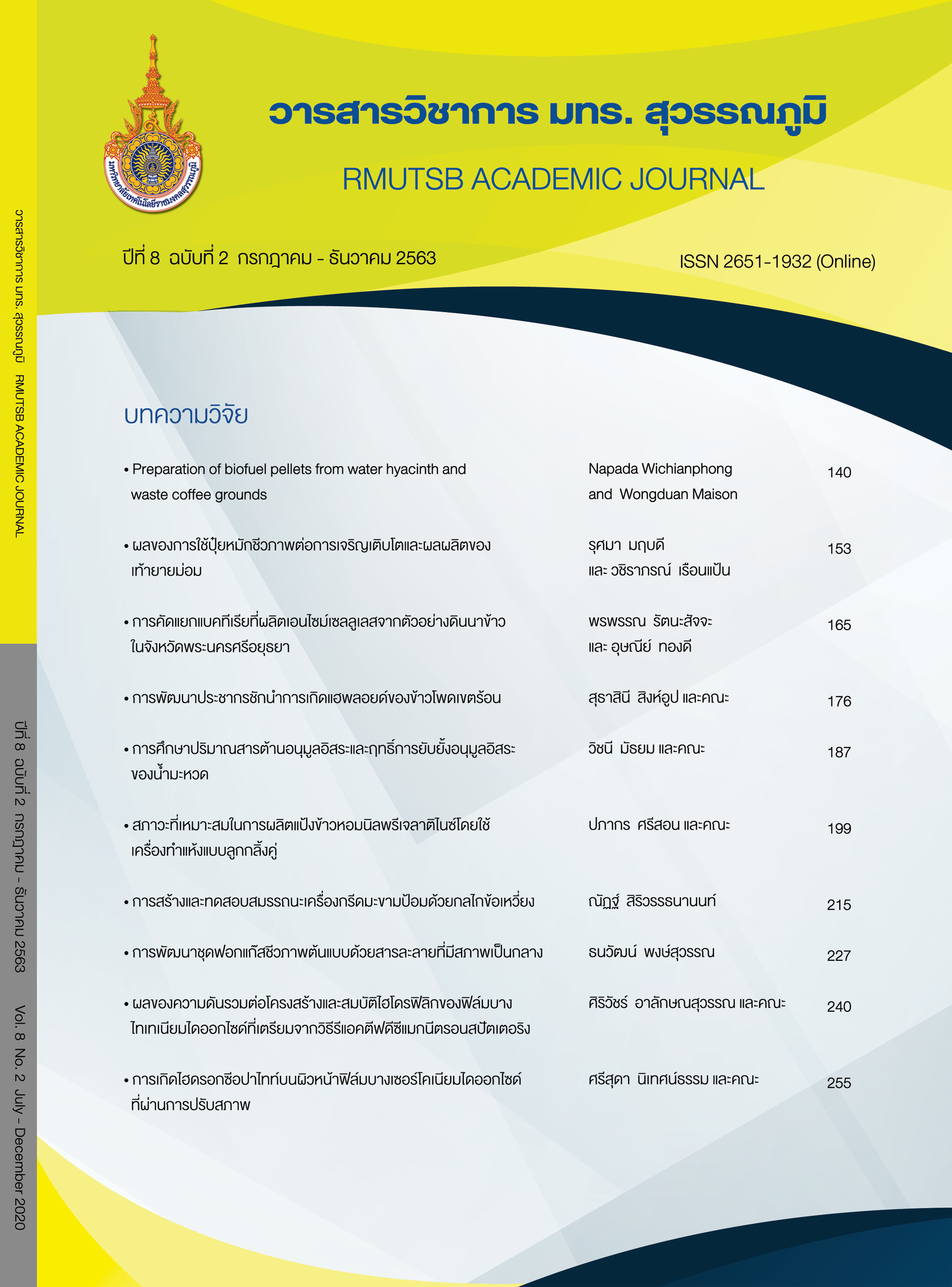The isolation of cellulase producing bacteria from paddy field soil samples in Phra Nakhon Si Ayutthaya province
Main Article Content
Abstract
The objective of this research was to isolate cellulase producing bacteria from rice paddy soil samples in Phra Nakhon Si Ayutthaya province. Soil samples of rice fields in five districts, namely Bangzai, Bangban, Tharuea, Phachi and Wangnoi, were used to screen for cellulase producing bacteria by serial ten-fold dilution method on cellulose-degrading culture medium. The bacterial colonization showed in the range of 1.06-6.87×106 CFU/g, and twenty-six isolates of bacteria were isolated. Morphological characterization of most isolates was gram-positive rod-shaped bacteria (80.77%). The results of cellulase production test on carboxymethyl cellulose agar were found that only four isolates (15.38%) produced cellulase, which a halo zone around the colony larger than the zone produced by positive control bacteria, Paenibacillus curdlanolyticus strain B-6. The isolate PC-C-1 had the highest halo zone size (2.56±1.03 centimeters). Moreover, the rice straw degradation test of isolate PC-C-1 in nutrient broth added 5% rice straw at 1×108 cell/mL showed digestion of rice straw up to 64.80%. These results can be used as preliminary data for further studies of the practical application in rice straw degradation by bacteria, which is an agricultural waste reduction in the future.
Article Details
Published manuscript are the rights of their original owners and RMUTSB Academic Journal. The manuscript content belongs to the authors' idea, it is not the opinion of the journal's committee and not the responsibility of Rajamangala University of Technology Suvarnabhumi
References
Ahmed, A. A. Q., Babalola, O. O., & McKay, T. (2017). Cellulase and xylanase producing bacterial isolates with the ability to saccharify wheat straw and their potential use in the production of pharmaceuticals and chemicals from lignocellulosic material. Waste and Biomass Valorization, 9(5), 765-775.
Balasubramanian, N., Toubarro, D., Teixeira, M., & Simos, N. (2012). Purification and biochemical characterization of a novel thermos-stable carboxymethyl cellulose from Bacillus mycoides S122C. Applied Biochemistry and Biotechnology, 168(8), 2191-2204.
Chakdar, H., Kumar, M., Pandiyan, K., Singh, A., Nanjappan, K., Kashyap, P. L., & Srivastava, A. K. (2016). Bacterial xylanases: biology to biotechnology. 3 Biotech, 6(2),150.
Doungwongsa, I., & Losirikul, M. (2010). The rice straw management for N, P and K element conservation in the paddy field, Laos (Master’s thesis). Ubon Ratchathani University, Ubon Ratchathani. (in Thai)
Gilbert, H. J., & Hazlewood, P. (1993). Bacterial cellulases and xylanases. Journal of Microbiology, 139(1), 187-194.
Hamarashid, N, H., Othman, M. A., & Hussain, M. A. H. (2010). Effects of soil texture on chemical composition, microbial populations and carbon mineralization in soil. The Egyptian Society of Experimental Biology, 6(1), 59-64.
He, Y. L., Ding, Y. F., & Long, Y. Q. (1991). Two cellulolytic Clostridium species: Clostridium cellulosi sp. nov. and Clostridium cellulofermentans sp. nov. International Journal of Systematic Bacteriology, 14(2), 306-309.
Johnsen, H. R., & Krause, K. (2014). Cellulase activity screening using pure carboxymethylcellulose: application to soluble cellulolytic samples and to plant tissue prints. International Journal of Molecular Sciences, 15(1), 830-838.
Liang, Y. L., Zhang, Z., Wu, M., Wu, Y., & Feng, J. X. (2014). Isolation, screening, and identification of cellulolytic bacteria from natural reserves in the subtropical region of China and optimization of cellulase production by Paenibacillus terrae ME27-1. Journal of Biomedicine and Biotechnology, 2014(5), 1-13.
Lu, Y., & Mosier, N. S. (2007). Biomimetic catalysis for hemicellulose hydrolysis in corn stover. Biotechnology Progress, 23(1), 116-123.
Malherbe, S., & Cloete, T. E. (2002). Lignocellulose biodegradation: fundamentals and applications. Environmental Science and Bio/Technology, 1, 105-114.
Manowattana, A., & Leksawasdi, N. (2014). Kinetic modeling enzyme xylanase (Master’s thesis). Chiang Mai University, Chiang Mai. (in Thai)
Mawadza, C. H., Rahni, R. Z., & Bo, M. (2000). Purification and characterization of cellulases produced by two Bacillus strains. Journal of Biotechnology, 83(3), 177-187.
Nafi, U. A., Usman, M. H., Abdullahi, B. Y., Mustapha, G., & Maiturare, H. M. (2017). Screening and identification of cellulase-producing bacteria isolated from rumen of camel in Sokoto main abattoir. Scientific and Management, 5(7), 5826-5832.
Pason, P., Kyu, K. L., & Ratanakhanokchai, K. (2006). Paenibacillus curdanolyticus strain B-6 xylanolytic-cellulolytic enzyme system that degrades insoluble polysaccharides. Applied and Environmental Microbiology, 72(4), 2483-2490.
Prabhu, M., Rao, N., & Li, W. J. (2017). Chapter 4: Microbial cellulose and xylanase: their sources and application. Advances in Biochemistry & Applications in Medicine, 2017, 1-20.
Poodngam, J. (2014). Isolation and selection of Actinomycetes capability to degrade lignocelluloses compounds on soil at the Namtok Yong National Park. RMUTSB Academic Journal, 2(2), 109-120. (in Thai)
Subramaniyan, S., & Prema, P. 2000. Cellulase-free xylanase from Bacillus and other microorganism. FEMS Microbiology Letter, 183(1), 1-7.
Supasinsathit, A. (2012). Energy from biomass with high lignocellulose. Environmental Journal, 16(2), 36-43. (in Thai)
Suphanburi Land Development Station. (2014). The incorporation of rice straw and crop residues after harvesting. Retrieved 15 November 2019, from http://r01.ldd.go.th/spb/. (in Thai)
Tachaapaikoon, C., Kosugi, A., Pason, P., Waeonukul, R., Ratanakhanokchai, K, Kyu, K. L., Arai, T., Murata, Y., & Mori, Y. (2012). Isolation and characterization of a new cellulosome-producing Clostridium thermocellum strain. Biodegradation, 23(1), 57-68.
Thanasrirangkul, C., Pinjai, P., & Vaithanomsat, P. (2018). Screening of cellulase producing bacteria and efficiency of lignocellulosic decomposition. King Mongkut’s Agricultural Journal, 36(3), 1-12. (in Thai)
Thanonkeo, P. (1995). Optimal conditions of cellulase production from fungi isolated from Agave sisalana Perrine plantations (Master’s thesis). Chaulalongkorn University, Bangkok. (in Thai)
Töysä, T., & Hänninen, O. (2017). Soil pH, Ca and Mg stability and pH association with temperature a groundwater silicon. Journal of Scientific & Technical Research, 1(7), 1851-1853.
Warnick, T. A., Methe, B. A., & Leschine, S. B. (2002). Clostridium phytofermentans sp. nov., a cellulolytic mesophile from forest soil. International Journal of Systematic and Evolutionary Microbiology, 52(4), 1155-1160.
Yin, L. J., Huang, P. S., & Lin, H. H. (2010). Isolation of cellulose-producing bacteria and characterization of the cellulose from the isolated bacterium Cellulomonas sp. YJ5. Journal of Agricultural & Food Chemistry, 58(17), 9833-9837.


